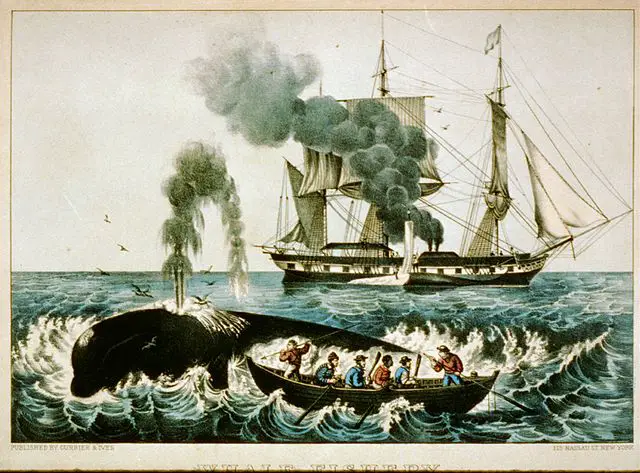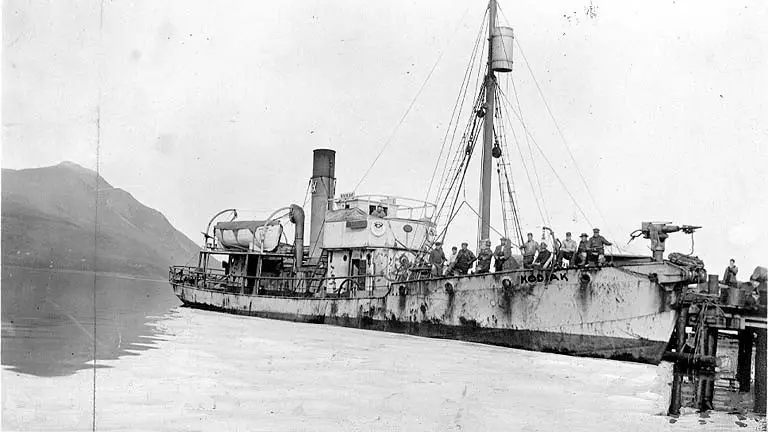Whaling Industry New Bedford
During the industrial revolution, hunting and killing whales were critical in supplying products for oil lamps, candle wax, detergents, and meat.
The profit from a successful kill of a sperm whale could bring around 25-40 barrels of whale oil. In the 1800s, New Bedford, Massachusetts, was an almost perfect location for the whaling industry of the developing new country.

Although whaling started in the area in the 1700s, by around 1823, New Bedford experienced an explosive success in the industry.
While we may be more aware today of the damages that humans can cause in nature, you have to remember that during the days of exploration and expansion, they never considered that their actions could be harmful.
In the minds of those that were claiming new lands and hunting and killing wildlife, they thought that there was an unlimited supply that was theirs for the taking.
We have since learned of the devastation that this attitude has caused, and the destruction of whale species due to the whaling industry is an important example.
- New Bedford competed with a few other cities for whaling, but once the railroad arrived in the 1840s, New Bedford became one of the hottest locations for whaling. The railroad brought easy commutes to the markets in Boston and New York, and at one point, New Bedford was the richest city in the world.
- The whaling industry in New Bedford didn’t just employ hundreds of people. It supported ships and industries such as architecture and fashion. The use of whale oil and parts expanded into almost every area of life and was exported to countries around the world.
- New Bedford’s whalers mainly hunted specific whale species that included: Sperm whales, North Atlantic Right whales, Grey whales, and Bowhead whales. Although little was known about the migration patterns of the whales, they knew that many species showed up in the waters not far from New Bedford.
- Whalers would set out on ships armed with huge and powerful spearguns. They had men perched in the upper sails to look out for the water spouts that would alert them that a whale was close. The ships would chase down the whale and let the spear loose to pierce and kill the whale. Death for the whale was often long, painful, and torturous. Whalers would often kill a whale calf just so they could get to the mother. A successful voyage that killed fifty whales could take up to four years.
- Whaling was happening around the world, and those that started studying the whales began to realize that some of the whale species were being destroyed. However, whaling continued to be the most successful industry in New Bedford and to compete. They had to develop new technologies to get more whales. Faster ships were being developed by the Norwegians, and while these were being used by other whaling groups in other countries, New Bedford still relied on the older technologies.
- As competition became more difficult, there was an appearance of ships that were steam-powered and had more powerful harpoon cannons that were used for the kill. Other ships would accompany them as a kind of “factory ship” so that the whales were dragged in and processed on the spot.
- In a period of just about one hundred years, whale species were being reduced to around 2% of their original populations, with some from 5%-21% worldwide.
- Industry in New Bedford grew so that it didn’t just rely on whaling. New companies were founded that expanded into the textile industries and others, and as the whaling industry came to a halt, these new industries maintained New Bedford’s success as a city.

Whaling steamer Kodiak and its crew
Q&A:
What were the four products that whale parts and contents were used for?
Oil lamps, candle wax, detergents, and meat
How many years did it sometimes take to bring in 50 whales?
4
What other industry did New Bedford turn to as part of their city expansion?
Textiles
How many barrels of oil would an average Sperm whale bring to the whalers?
25-40
Why did people around the world kill whales to the point of near extinction?
They thought that there was an unlimited supply and that their actions wouldn’t be harmful
What new industry happened in the 1840s that launched even more success for the New Bedford whalers?
The railroad



